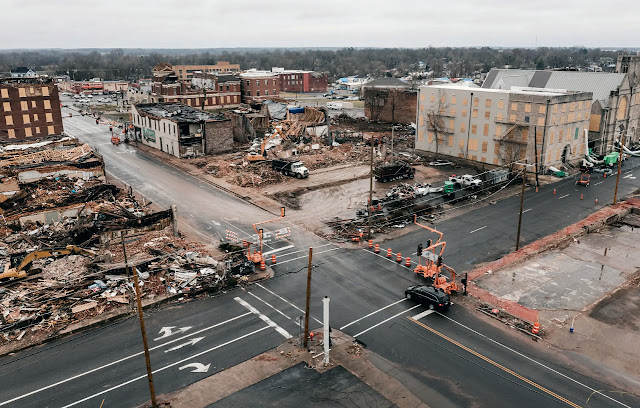Tornado cleanup is more than physical; loss and suffering take emotional and psychological tolls that can be harder to deal with

Downtown Mayfield is pictured on Feb. 2. (Photo by William Widmer for The New York Times)
—–
About 40 percent of the debris from the gigantic tornado that plowed through 200 miles of Western Kentucky Dec. 10 has been picked up, but Rick Rojas of The New York Times reports, “Communities along that path are now confronting another form of devastation that is less tangible but just as staggering: the emotional and psychological toll that comes from enduring so much loss and suffering.”
Rojas adds, “The long and unforgiving reach of the storm is evident in nights that are sleepless or disrupted by harrowing dreams, unexpected bursts of tears, flashes of anger, fuzzy memories, a diminished appetite — the multitude of ways that trauma can manifest itself after a disaster. Now, more than a month after the storm, some — because of resources or simple luck — have been able to emerge from the shock of the storm. On the other side of a growing gulf, though, are the many others whose lives were upended and are still being whirled by turbulence. For them, mental health experts warn, the sense of security and calm integral to recovery remains elusive.”
The focus of Rojas’s story is Mayfield, a town of 10,000 “walloped by the initial shock of seeing entire stretches pulverized by the worst of the storm. Downtown remains mangled,” he writes. “People point to piles of debris and refer to them by what they used to be: a church, a shop, a family home.”
Steven Elder, the president of the Mayfield Community Foundation, which is raising money to help residents recover, told Rojas that it has been hardest for people who were already disadvantaged: “People were hurting long before Dec. 10. That’s the disaster that’s going to set these people back a lifetime. They’ve fallen into a hole they’ll never get out of.”
Rojas focuses on several victims, primarily Isaiah Holt, who “sustained nerve damage while trapped in the rubble of the candle factory where he worked and fears it will be permanent. His skin is etched with cuts and chemical burns. A strong gust of wind or an exploding building in an action movie can unleash in him a rush of terror. Lately he has spent $400 on DoorDash deliveries, as the pain — physical but also psychological — makes it difficult to venture outside.”
“I felt good today,” Holt told Rojas after making phone calls and taking a shower, but “He confessed that it was only the second one he had taken in 2022.”
“That’s what ‘feeling good’ means, just be feeling normal,” Holt said. “What makes it hard is I have nothing to do right now. I’m single with no kids, and I have no job.” So, Rojas writes, “He sits and he stews.”
Holt was “pinned under the rubble for hours,” Rojas reports. “He drained the battery on his cellphone posting videos on Snapchat, desperate to tell his family and friends he loved them. He feared he would not make it out. He feared for his brother, who worked there too and was similarly trapped. Weeks later, Mr. Holt is grateful to be alive and for the company of his brother, who spent several days in a coma but is now recovering at home. But he is also depressed and saddled with new fears.”
Holt “lost 20 pounds in the hospital and feels out of shape. He is even more concerned about his mental health,” Rojas writes, quoting him: “An able mind is 10 times better than an able body.” Holt has already had post-traumatic stress, after serving in the Army as a door gunner on a helicopter.
“Eventually, it got to me,” Johnson told him. “I’m a fisherman. I was at the lake one day. I turned into the lake — that’s how hard I cried. You cry so hard your throat gets sore and you can’t speak, and finally, it was over. I just put my feet on the ground and said, ‘Get back to work. You’ve got a job to do.’”